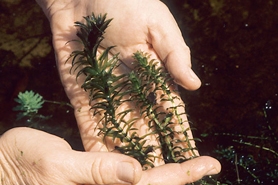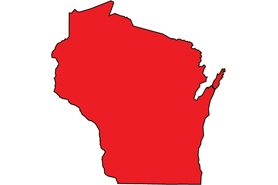Egeria
(Egeria densa)
Egeria is a submersed aquatic plant native to South America. It was first verified in the United States in the 1890s and was likely introduced through the aquarium and water garden trade. Egeria is prevalent in the southern, western, and eastern United States. There are some established populations in northern Illinois and elsewhere throughout the Midwest. However, it has not yet been seen in Wisconsin. Egeria reproduces exclusively via fragmentation in the United States, where only male plants have been found.
Other names for this plant include:
- Common names: Brazilian elodea, leafy elodea, dense waterweed, anacharis, Brazilian waterweed
- Scientific names: Elodea densa, Anacharis densai, Philotria densa
Classification in Wisconsin: Prohibited
- Ecological and Socio-economic Impacts
-
- Some waterbodies can form large vegetation mats that impede recreational activities like fishing, boating, and swimming.
- Egeria is tolerant of low CO2 levels, low light levels, and a wide range of temperatures, which may allow it to outcompete native plants.
- Identification
-
Leaves: Finely serrated and often ½ to 1 inch long and ¼ inch wide. Leaves are arranged in whorls of 3 to 8 around the stem.
Flowers: White with three petals; can be up to ¾ inch across. Flowers typically float at the water's surface or on short stalks rising 1 inch above the surface.
Roots: Slender, unbranched, and pale. Plant fragments containing double nodes can grow roots and produce new plants.
Similar species: Native common waterweed (Elodea canadensis), non-native hydrilla (Hydrilla verticillata).
- Distribution
-
See the reported locations of Egeria in Wisconsin.
Do you know of other populations? Please send us a report.
- Control
-
Prevention: The best way to keep a lake free of Egeria is to prevent its establishment. Wisconsin's invasive species law prohibits the transport of aquatic plants, live animals and water from a waterbody, with some exceptions for bait.
- Before leaving the boat launch, conduct the following actions required by law:
- Inspect and remove aquatic plants and animals from boats and equipment.
- Drain all water from the boat and equipment.
- Before entering another waterbody
- Spray boat and equipment with high-pressure hot water, or
- Allow the boat and equipment to dry out of water for at least five days.
Mechanical: Since Egeria fragments can produce new plants, automatic cutting and raking are generally not advised. Hand-harvesting may be effective for small populations if all plant fragments are removed.
Chemical: Herbicides that are approved for aquatic use in Wisconsin and are labeled to control Egeria include copper, diquat, endothall, fluridone, imazamox, and penoxsulam. An approved Chapter NR 107 permit is required to use herbicides in a Wisconsin waterbody to control aquatic plants.
- Before leaving the boat launch, conduct the following actions required by law:
- Resources
- Links for more information:



